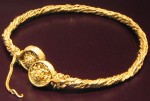 David Booth, the amateur metal detector enthusiast who found a hoard of 4 gold torcs near Stirling, Scotland, last fall, will receive £462,000 ($740,000) as a reward. Not bad for his first time out with the wand.
David Booth, the amateur metal detector enthusiast who found a hoard of 4 gold torcs near Stirling, Scotland, last fall, will receive £462,000 ($740,000) as a reward. Not bad for his first time out with the wand.
Unlike the treasure laws in England which have been so sadly exposed in the matter of the Crosby Garret Roman cavalry helmet, Scottish law establishes all archaeological objects found in Scotland are the property of the government. Finders have no ownership rights and must report all finds to the Treasure Trove Unit. The Scottish Archaeological Finds Allocation Panel then studies the object and the circumstances of its discovery and determine where the find should go and how much the recipients should pay as an ex gratia reward to the discoverer.
In this case, the panel has determined that the torcs will go to the National Museums Scotland and £462,000 of their pounds will go to David Booth. The landowner of the property where the torcs were found will also receive a reward, probably in the same amount. If it works how it works in England, the panel assesses fair value then splits the amount between finder and landowner.
The decision was announced by the the Queen’s and Lord Treasurer’s Remembrancer Catherine Dyer, who as the Crown’s representative in Scotland can claim buried archaeological or historic items.
Ms Dyer said: “This is a very significant find, the most important hoard of Iron Age gold ever found in Scotland.
“That these stunning artefacts have been unearthed in such excellent condition after being buried for 2,000 years is simply amazing.”
The four torcs were just six inches beneath the surface when Mr Booth discovered them with his metal detector.
Professor Ian Ralston, chairman of Safap, said: “The panel is grateful to the finder for reporting these highly important finds in good time and for the further assistance from the finder during fieldwork by the National Museum at the site of the discovery.
“This has allowed much greater understanding of the archaeological context of these four exceptional items.”
Because of Booth’s quick reporting of his find, archaeologists were able to examine the site just a few hours after he disturbed it. They found evidence that the torcs had originally been buried inside a roundhouse. Since hoards are usually religious offerings or treasure buried under duress, it’s possible that the roundhouse was a religious building and the gold torcs sacrifices.
The torcs themselves are packed with historical significance. They date to between 300 and 100 B.C. Two of them are of a simple twisted designed likely to have been made locally. The third one is an annular torc broken into 2 pieces, which would have had a hinge and catch as a clasp but those parts are missing. Its elaborate design mark as it from Toulouse, and it’s the first of its kind ever found in the British Isles.
 The fourth torc is made from eight gold wires twisted together with decorated ends and a safety chain. These features are a combination of Mediterranean craftsmanship and traditional Iron Age themes, which suggests that Iron Age Scotland had more links to the Mediterranean than previously realized.
The fourth torc is made from eight gold wires twisted together with decorated ends and a safety chain. These features are a combination of Mediterranean craftsmanship and traditional Iron Age themes, which suggests that Iron Age Scotland had more links to the Mediterranean than previously realized.
Dr Gordon Rintoul, Director of the National Museums of Scotland, says they’re delighted to have the opportunity to secure these unique artifacts for the national collection. They have to raise the money first and are looking into various funding options, she said obliquely. I’m not sure what happens if they can’t raise the full amount, but although Rintoul uses careful conditionals, I doubt they’re in any danger of not raising the reward money.